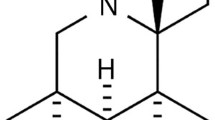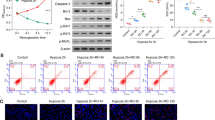Abstract
Diabetes increases the risk of cardiovascular diseases. Berberine (BBR), an isoquinoline alkaloid used in Chinese medicine, exerts anti-diabetic effect by lowering blood glucose and regulating lipid metabolism. It has been reported that BBR decreases mortality in patients with chronic congestive heart failure. However, the molecular mechanisms of these beneficial effects are incompletely understood. In the present study, we sought to determine whether BBR exerts cardioprotective effect against ischemia/reperfusion (I/R) injury in diabetic rats and the underlying mechanisms. Male Sprague-Dawley rats were injected with low dose streptozotocin and fed with a high-fat diet for 12 weeks to induce diabetes. The diabetic rats were intragastrically administered with saline or BBR (100, 200 and 400 mg/kg/d) starting from week 9 to 12. At the end of week 12, all rats were subjected to 30 min of myocardial ischemia and 3 h of reperfusion. BBR significantly improved the recovery of cardiac systolic/diastolic function and reduced myocardial apoptosis in diabetic rats subjected to myocardial I/R. Furthermore, in cultured neonatal rat cardiomyocytes, BBR (50 μmol/L) reduced hypoxia/reoxygenation-induced myocardial apoptosis, increased Bcl-2/Bax ratio and decreased caspase-3 expression, together with enhanced activation of PI3K–Akt and increased adenosine monophosphate-activated protein kinase (AMPK) and eNOS phosphorylation. Pretreatment with either PI3K/Akt inhibitor wortmannin or AMPK inhibitor Compound C blunted the anti-apoptotic effect of BBR. Our findings demonstrate that BBR exerts anti-apoptotic effect and improves cardiac functional recovery following myocardial I/R via activating AMPK and PI3K–Akt–eNOS signaling in diabetic rats.







Similar content being viewed by others
References
Yang W, Lu J, Weng J, Jia W, Ji L, Xiao J et al (2010) Prevalence of diabetes among men and women in China. N Engl J Med 362:1090–1101
Xie N, Zhang W, Li J, Liang H, Zhou H, Duan W et al (2011) α-Linolenic acid intake attenuates myocardial ischemia/reperfusion injury through anti-inflammatory and anti-oxidative stress effects in diabetic but not normal rats. Arch Med Res 42:171–181
Thom T, Haase N, Rosamond W, Howard VJ, Rumsfeld J, Manolio T et al (2006) Heart disease and stroke statistics—2006 update: a report from the American Heart Association Statistics Committee and Stroke Statistics Subcommittee. Circulation 113:e85–e151
Woodfield SL, Lundergan CF, Reiner JS, Greenhouse SW, Thompson MA, Rohrbeck SC et al (1996) Angiographic findings and outcome in diabetic patients treated with thrombolytic therapy for acute myocardial infarction: the GUSTO-I experience. J Am Coll Cardiol 28:1661–1669
Lee MG, Jeong MH, Ahn Y, Chae SC, Hur SH, Hong TJ et al (2009) Comparison of clinical outcomes following acute myocardial infarctions in hypertensive patients with or without diabetes. Korean Circ J 39:243–250
Zhang Y, Wei L, Sun D, Cao F, Gao H, Zhao L et al (2010) Tanshinone IIA pretreatment protects myocardium against ischaemia/reperfusion injury through the phosphatidylinositol 3-kinase/Akt-dependent pathway in diabetic rats. Diabetes Obes Metab 12:316–322
Lekli I, Szabo G, Juhasz B, Das S, Das M, Varga E et al (2008) Protective mechanisms of resveratrol against ischemia-reperfusion-induced damage in hearts obtained from Zucker obese rats: the role of GLUT-4 and endothelin. Am J Physiol Heart Circ Physiol 294:H859–H866
Chu LM, Osipov RM, Robich MP, Feng J, Sheller MR, Sellke FW (2010) Effect of thrombin fragment (TP508) on myocardial ischemia reperfusion injury in a model of type 1 diabetes mellitus. Circulation 122:S162–S169
Dong H, Wang N, Zhao L, Lu F (2012) Berberine in the treatment of type 2 diabetes mellitus: a systemic review and meta-analysis. Evid Based Complement Alternat Med 2012:591654
Chueh WH, Lin JY (2011) Berberine, an isoquinoline alkaloid in herbal plants, protects pancreatic islets and serum lipids in nonobese diabetic mice. J Agric Food Chem 59:8021–8027
Dong SF, Hong Y, Liu M, Hao YZ, Yu HS, Liu Y et al (2011) Berberine attenuates cardiac dysfunction in hyperglycemic and hypercholesterolemic rats. Eur J Pharmacol 660:368–374
Wang Y, Huang Y, Lam KS, Li Y, Wong WT, Ye H et al (2009) Berberine prevents hyperglycemia-induced endothelial injury and enhances vasodilatation via adenosine monophosphate-activated protein kinase and endothelial nitric oxide synthase. Cardiovasc Res 82:484–492
Zhang H, Wei J, Xue R, Wu JD, Zhao W, Wang ZZ et al (2010) Berberine lowers blood glucose in type 2 diabetes mellitus patients through increasing insulin receptor expression. Metabolism 59:285–292
Zhou L, Yang Y, Wang X, Liu S, Shang W, Yuan G et al (2007) Berberine stimulates glucose transport through a mechanism distinct from insulin. Metabolism 56:405–412
Zhang Y, Li X, Zou D, Liu W, Yang J, Zhu N et al (2008) Treatment of type 2 diabetes and dyslipidemia with the natural plant alkaloid berberine. J Clin Endocrinol Metab 93:2559–2565
Turner N, Li JY, Gosby A, To SW, Cheng Z, Miyoshi H et al (2008) Berberine and its more biologically available derivative, dihydroberberine, inhibit mitochondrial respiratory complex I: a mechanism for the action of berberine to activate AMP-activated protein kinase and improve insulin action. Diabetes 57:1414–1418
Yin J, Gao Z, Liu D, Liu Z, Ye J (2008) Berberine improves glucose metabolism through induction of glycolysis. Am J Physiol Endocrinol Metab 294:E148–E156
Lee YS, Kim WS, Kim KH, Yoon MJ, Cho HJ, Shen Y et al (2006) Berberine, a natural plant product, activates AMP-activated protein kinase with beneficial metabolic effects in diabetic and insulin-resistant states. Diabetes 55:2256–2264
Kong W, Wei J, Abidi P, Lin M, Inaba S, Li C et al (2004) Berberine is a novel cholesterol-lowering drug working through a unique mechanism distinct from statins. Nat Med 10:1344–1351
Wang C, Li J, Lv X, Zhang M, Song Y, Chen L et al (2009) Ameliorative effect of berberine on endothelial dysfunction in diabetic rats induced by high-fat diet and streptozotocin. Eur J Pharmacol 620:131–137
Cui G, Qin X, Zhang Y, Gong Z, Ge B, Zang YQ (2009) Berberine differentially modulates the activities of ERK, p38 MAPK, and JNK to suppress Th17 and Th1 T cell differentiation in type 1 diabetic mice. J Biol Chem 284:28420–28429
Ko BS, Choi SB, Park SK, Jang JS, Kim YE, Park S (2005) Insulin sensitizing and insulinotropic action of berberine from Cortidis rhizoma. Biol Pharm Bull 28:1431–1437
Yin J, Hu R, Chen M, Tang J, Li F, Yang Y et al (2002) Effects of berberine on glucose metabolism in vitro. Metabolism 51:1439–1443
Zhang KR, Liu HT, Zhang HF, Zhang QJ, Li QX, Yu QJ et al (2007) Long-term aerobic exercise protects the heart against ischemia/reperfusion injury via PI3 kinase-dependent and Akt-mediated mechanism. Apoptosis 12:1579–1588
Yue TL, Wang C, Gu JL, Ma XL, Kumar S, Lee JC et al (2000) Inhibition of extracellular signal-regulated kinase enhances Ischemia/Reoxygenation-induced apoptosis in cultured cardiac myocytes and exaggerates reperfusion injury in isolated perfused heart. Circ Res 86:692–699
Ma YG, Dong L, Ye XL, Deng CL, Cheng JH, Liu WC et al (2010) Activation of cloned BK(Ca) channels in nitric oxide-induced apoptosis of HEK293 cells. Apoptosis 15:426–438
Xing W, Yan W, Fu F, Jin Y, Ji L, Liu W et al (2009) Insulin inhibits myocardial ischemia-induced apoptosis and alleviates chronic adverse changes in post-ischemic cardiac structure and function. Apoptosis 14:1050–1060
Li J, Zhang H, Wu F, Nan Y, Ma H, Guo W et al (2008) Insulin inhibits tumor necrosis factor-alpha induction in myocardial ischemia/reperfusion: role of Akt and endothelial nitric oxide synthase phosphorylation. Crit Care Med 36:1551–1558
Ma H, Zhang HF, Yu L, Zhang QJ, Li J, Huo JH et al (2006) Vasculoprotective effect of insulin in the ischemic/reperfused canine heart: role of Akt-stimulated NO production. Cardiovasc Res 69:57–65
Saraste A, Pulkki K, Kallajoki M, Henriksen K, Parvinen M, Voipio-Pulkki LM (1997) Apoptosis in human acute myocardial infarction. Circulation 95:320–323
Ohno M, Takemura G, Ohno A, Misao J, Hayakawa Y, Minatoguchi S et al (1998) “Apoptotic” myocytes in infarct area in rabbit hearts may be oncotic myocytes with DNA fragmentation: analysis by immunogold electron microscopy combined with In situ nick end-labeling. Circulation 98:1422–1430
Gao F, Gao E, Yue TL, Ohlstein EH, Lopez BL, Christopher TA et al (2002) Nitric oxide mediates the antiapoptotic effect of insulin in myocardial ischemia-reperfusion: the roles of PI3-kinase, Akt, and endothelial nitric oxide synthase phosphorylation. Circulation 105:1497–1502
Misao J, Hayakawa Y, Ohno M, Kato S, Fujiwara T, Fujiwara H (1996) Expression of bcl-2 protein, an inhibitor of apoptosis, and Bax, an accelerator of apoptosis, in ventricular myocytes of human hearts with myocardial infarction. Circulation 94:1506–1512
Nishikawa S, Tatsumi T, Shiraishi J, Matsunaga S, Takeda M, Mano A et al (2006) Nicorandil regulates Bcl-2 family proteins and protects cardiac myocytes against hypoxia-induced apoptosis. J Mol Cell Cardiol 40:510–519
Zeng XH, Zeng XJ, Li YY (2003) Efficacy and safety of berberine for congestive heart failure secondary to ischemic or idiopathic dilated cardiomyopathy. Am J Cardiol 92:173–176
Guo Y, Pope C, Cheng X, Zhou H, Klaassen CD (2011) Dose-response of berberine on hepatic cytochromes P450 mRNA expression and activities in mice. J Ethnopharmacol 138:111–118
Seubert J, Yang B, Bradbury JA, Graves J, Degraff LM, Gabel S et al (2004) Enhanced postischemic functional recovery in CYP2J2 transgenic hearts involves mitochondrial ATP-sensitive K + channels and p42/p44 MAPK pathway. Circ Res 95:506–514
Fu J, Huang H, Liu J, Pi R, Chen J, Liu P (2007) Tanshinone IIA protects cardiac myocytes against oxidative stress-triggered damage and apoptosis. Eur J Pharmacol 568:213–221
Song JQ, Teng X, Cai Y, Tang CS, Qi YF (2009) Activation of Akt/GSK-3beta signaling pathway is involved in intermedin(1-53) protection against myocardial apoptosis induced by ischemia/reperfusion. Apoptosis 14:1061–1069
Yu W, Sheng M, Xu R, Yu J, Cui K, Tong J et al (2013) Berberine protects human renal proximal tubular cells from hypoxia/reoxygenation injury via inhibiting endoplasmic reticulum and mitochondrial stress pathways. J Transl Med 11:24
Gao F, Tao L, Yan W, Gao E, Liu HR, Lopez BL et al (2004) Early anti-apoptosis treatment reduces myocardial infarct size after a prolonged reperfusion. Apoptosis 9:553–559
Miller EJ, Li J, Leng L, McDonald C, Atsumi T, Bucala R et al (2008) Macrophage migration inhibitory factor stimulates AMP-activated protein kinase in the ischaemic heart. Nature 451:578–582
Ma H, Wang J, Thomas DP, Tong C, Leng L, Wang W et al (2010) Impaired macrophage migration inhibitory factor-AMP-activated protein kinase activation and ischemic recovery in the senescent heart. Circulation 122:282–292
Russell RR, Li J, Coven DL, Pypaert M, Zechner C, Palmeri M et al (2004) AMP-activated protein kinase mediates ischemic glucose uptake and prevents postischemic cardiac dysfunction, apoptosis, and injury. J Clin Invest 114:495–503
Stein SC, Woods A, Jones NA, Davison MD, Carling D (2000) The regulation of AMP-activated protein kinase by phosphorylation. Biochem J 345(Pt 3):437–443
Zhang W, Wang R, Han SF, Bu L, Wang SW, Ma H et al (2007) Alpha-linolenic acid attenuates high glucose-induced apoptosis in cultured human umbilical vein endothelial cells via PI3K/Akt/eNOS pathway. Nutrition 23:762–770
Ansley DM, Wang B (2013) Oxidative stress and myocardial injury in the diabetic heart. J Pathol 229:232–241
Boo YC, Sorescu G, Boyd N, Shiojima I, Walsh K, Du J et al (2002) Shear stress stimulates phosphorylation of endothelial nitric-oxide synthase at Ser1179 by Akt-independent mechanisms: role of protein kinase A. J Biol Chem 277:3388–3396
Zhang Y, Lee TS, Kolb EM, Sun K, Lu X, Sladek FM et al (2006) AMP-activated protein kinase is involved in endothelial NO synthase activation in response to shear stress. Arterioscler Thromb Vasc Biol 26:1281–1287
Acknowledgments
This work was supported by the State Key Program of National Natural Science Foundation of China (No. 81030005) and grants from the National Nature Science Foundation of China (Nos. 30800432, 81270301), Traditional Chinese Medicine Foundation of Shaanxi Province (No. JC38) and National Science and Technology Major Project (No. 2009ZX09301-009).
Conflict of interest
The authors declare that they have no conflict of interest.
Author information
Authors and Affiliations
Corresponding authors
Additional information
Keke Chen and Guohua Li contributed equally to this study.
Rights and permissions
About this article
Cite this article
Chen, K., Li, G., Geng, F. et al. Berberine reduces ischemia/reperfusion-induced myocardial apoptosis via activating AMPK and PI3K–Akt signaling in diabetic rats. Apoptosis 19, 946–957 (2014). https://doi.org/10.1007/s10495-014-0977-0
Published:
Issue Date:
DOI: https://doi.org/10.1007/s10495-014-0977-0




